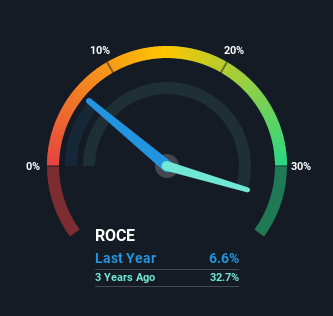There Are Reasons To Feel Uneasy About Cactus' (NYSE:WHD) Returns On Capital
If we want to find a stock that could multiply over the long term, what are the underlying trends we should look for? Ideally, a business will show two trends; firstly a growing return on capital employed (ROCE) and secondly, an increasing amount of capital employed. This shows us that it's a compounding machine, able to continually reinvest its earnings back into the business and generate higher returns. However, after briefly looking over the numbers, we don't think Cactus (NYSE:WHD) has the makings of a multi-bagger going forward, but let's have a look at why that may be.
What is Return On Capital Employed (ROCE)?
For those who don't know, ROCE is a measure of a company's yearly pre-tax profit (its return), relative to the capital employed in the business. To calculate this metric for Cactus, this is the formula:
Return on Capital Employed = Earnings Before Interest and Tax (EBIT) ÷ (Total Assets - Current Liabilities)
0.066 = US$58m ÷ (US$964m - US$88m) (Based on the trailing twelve months to September 2021).
So, Cactus has an ROCE of 6.6%. Even though it's in line with the industry average of 6.7%, it's still a low return by itself.
See our latest analysis for Cactus
In the above chart we have measured Cactus' prior ROCE against its prior performance, but the future is arguably more important. If you'd like, you can check out the forecasts from the analysts covering Cactus here for free.
The Trend Of ROCE
When we looked at the ROCE trend at Cactus, we didn't gain much confidence. Around five years ago the returns on capital were 13%, but since then they've fallen to 6.6%. Given the business is employing more capital while revenue has slipped, this is a bit concerning. This could mean that the business is losing its competitive advantage or market share, because while more money is being put into ventures, it's actually producing a lower return - "less bang for their buck" per se.
The Key Takeaway
From the above analysis, we find it rather worrisome that returns on capital and sales for Cactus have fallen, meanwhile the business is employing more capital than it was five years ago. But investors must be expecting an improvement of sorts because over the last three yearsthe stock has delivered a respectable 35% return. Regardless, we don't feel too comfortable with the fundamentals so we'd be steering clear of this stock for now.
Cactus could be trading at an attractive price in other respects, so you might find our free intrinsic value estimation on our platform quite valuable.
While Cactus may not currently earn the highest returns, we've compiled a list of companies that currently earn more than 25% return on equity. Check out this free list here.
This article by Simply Wall St is general in nature. We provide commentary based on historical data and analyst forecasts only using an unbiased methodology and our articles are not intended to be financial advice. It does not constitute a recommendation to buy or sell any stock, and does not take account of your objectives, or your financial situation. We aim to bring you long-term focused analysis driven by fundamental data. Note that our analysis may not factor in the latest price-sensitive company announcements or qualitative material. Simply Wall St has no position in any stocks mentioned.
Have feedback on this article? Concerned about the content? Get in touch with us directly. Alternatively, email editorial-team (at) simplywallst.com.

